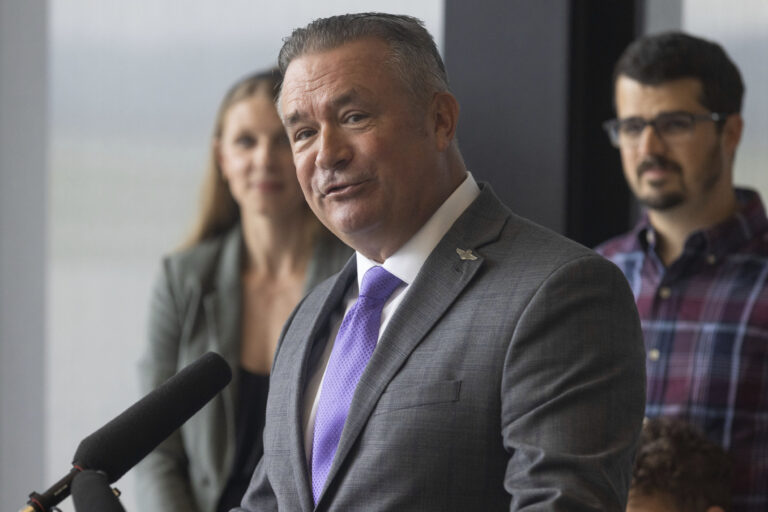A Republican congressman has warned that tariffs are having an outsized impact on his state’s economy.
“We’re now in a troubled time,” Nebraska Representative Don Bacon told CNN on Monday.
“And honestly, in Nebraska, the GDP here has decreased by 6 percent over the last year,” he continued. “And it’s all about trade. It’s all about getting corn and soybeans out the door.”
Why It Matters
Tariffs have not yet made successive dents in America’s economic growth rate this year, with GDP rebounding strongly in the second quarter from an import-driven contraction in the first. Extra reprieve has been provided by the temporary scaling back of China’s duties, and tariff-lowering trade deals being struck with a handful of nations.
However, many economists still expect tariffs to create headwinds for the U.S. economy in the coming months, with certain states—those reliant on imports and vulnerable to any reciprocal actions—expected to feel an outsized impact.
What To Know
Bacon, a centrist member of the GOP and frequent critic of President Donald Trump’s trade policies on both economic and constitutional grounds, appeared to be referencing first-quarter GDP growth figures, state estimates of which were released by the Bureau of Economic Analysis (BEA) in June.
Alongside Iowa, Nebraska’s 6.1 percent decline was the worst in the nation. This compared to a nationwide drop of 0.5 percent, with 39 states seeing contractions over the period.
“What we’re seeing is basically a recession economy in Nebraska and Iowa right now,” Bacon said in a separate interview.
Agriculture plays a central role in the economies of Nebraska and Iowa, which are among the leading national producers of corn, soybeans and wheat. Farmers and agricultural experts who spoke with Newsweek recently said that tariffs could further strain the sector’s already narrow margins, both through the negative impact on commodity prices and potential retaliatory actions damaging their exports.

Chris Machian/Omaha World-Herald via AP
U.S. GDP rebounded strongly in the second quarter, increasing at a better-than-expected annual rate of 3.0 percent according to last week’s advanced estimates from the BEA. The bureau said this reflected a “downturn in imports and an acceleration in consumer spending.”
July 29 also saw the International Monetary Fund (IMF) upgrade its global growth forecasts, owing to a weaker dollar, the extensions placed on tariff deadlines, and a general drop in the expected impacts of the “trade shock.” The U.S. was among the countries to see an upgrade, its GDP growth forecasts for both 2025 and 2026 increasing by 0.1 percent.
What People Are Saying
President Donald Trump, reacting to last week’s GDP growth estimates, said: “The number of 3 percent—the pace in the second quarter—we smashed all expectations. They thought it would be maybe a little bit less than 2, and it was 3, a little bit more than 3.”
White House press secretary Karoline Leavitt said: “Today, GDP growth came in above market expectations, and yesterday, consumer confidence rose. Americans trust in President Trump’s America First economic agenda that continues to prove the so-called ‘experts’ wrong. President Trump has reduced America’s reliance on foreign products, boosted investment in the U.S., and created thousands of jobs—delivering on his promise to Make America Wealthy Again.”
Thomas Sampson, a professor of economics at the London School of Economics, told Newsweek that there exists “too much uncertainty over the future of U.S. trade policy” to make confidence predictions about GDP growth in the future.
“But I do expect the tariff increases to act as a small drag on the U.S. economy,” he added, “slightly reducing growth compared to what would have been achieved otherwise.”
Bill Adams, chief economist at Comerica Bank, told Newsweek: “The second quarter GDP report has a great headline, but details were weaker. Real final sales to private domestic purchasers (Core GDP) grew at the weakest pace since the fourth quarter of 2022. Tariff uncertainty, a wait-and-see attitude among businesses, and sour consumer sentiment weighed on business and consumer spending in the second quarter.
“Combining the volatile first and second quarters, real GDP grew a sluggish 1.2 percent annualized in the first half of 2025,” he added. “This is a big slowdown from its 2.8 percent increase in 2024 and 2.9 percent increase in 2023.”
What Happens Next?
The BEA will release another set of estimates for second-quarter GDP growth later this month, followed by final estimates and state-by-state data in September.
Bacon announced in June he would not be seeking reelection in 2026.


